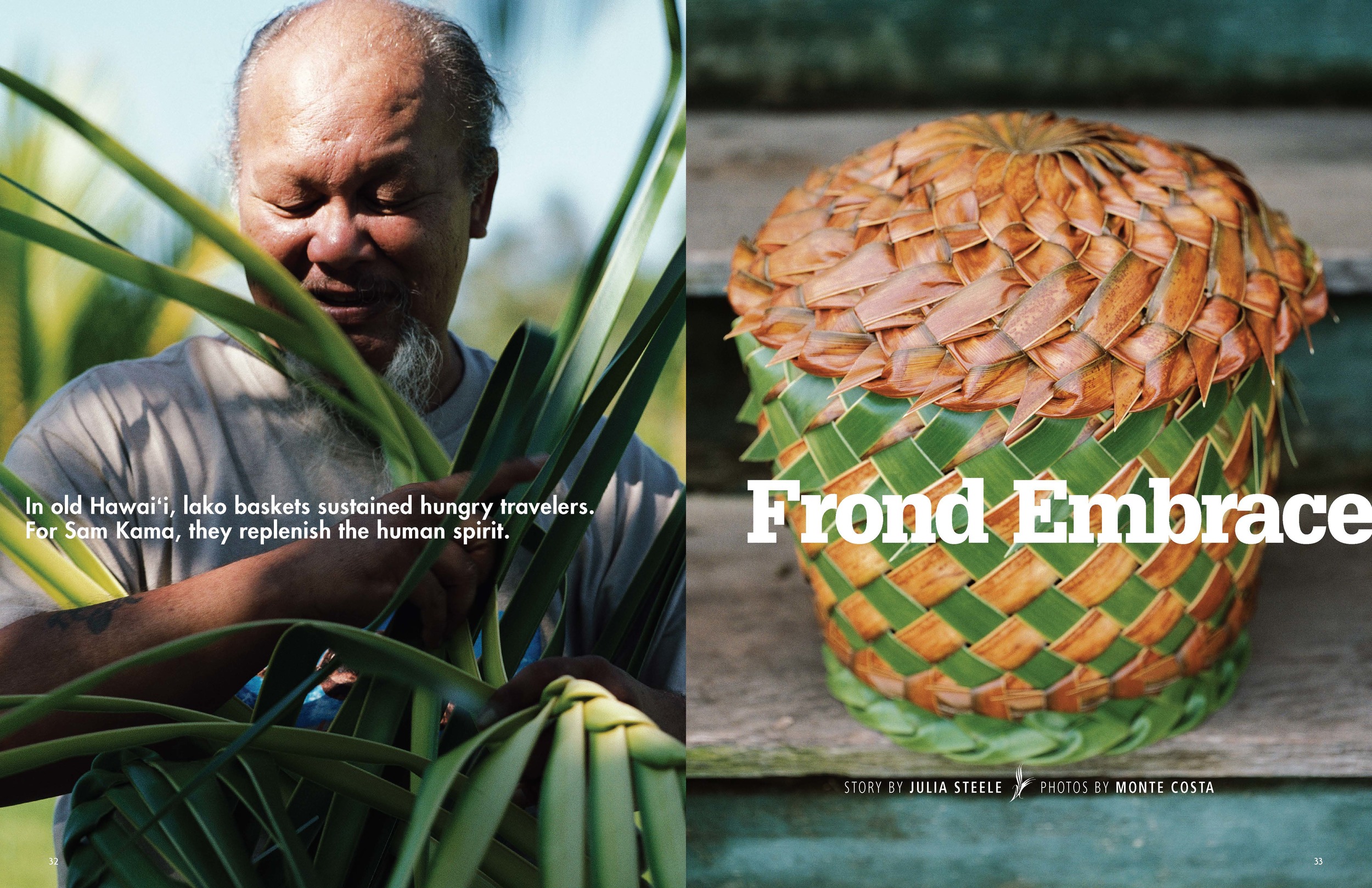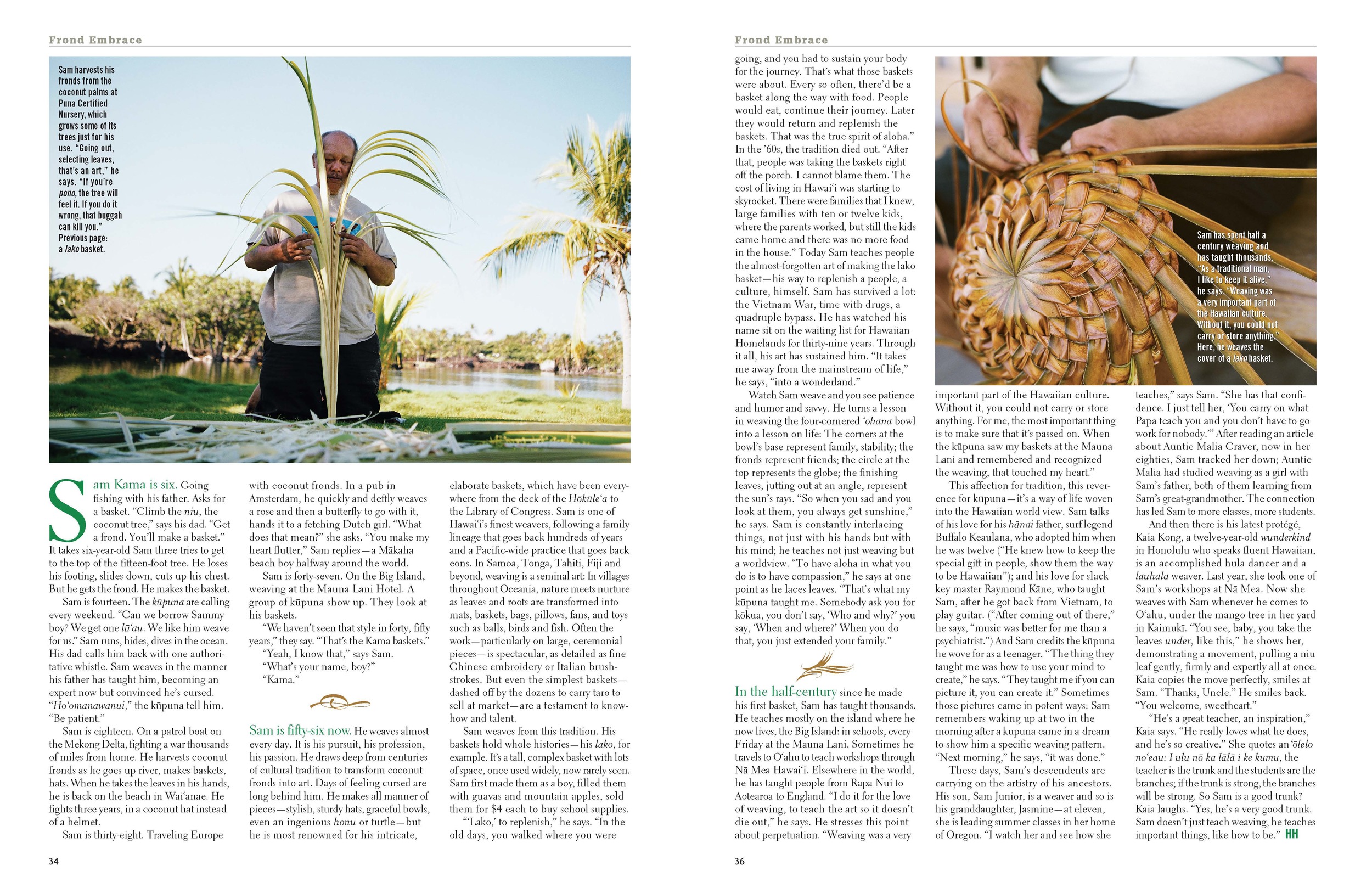Sam Kama is six. Going fishing with his father. Asks for a basket. “Climb the niu, the coconut tree,” says his dad. “Get a frond. You’ll make a basket.” It takes six-year-old Sam three tries to get to the top of the fifteen-foot tree. He loses his footing, slides down, cuts up his chest. But he gets the frond. He makes the basket.
Sam is fourteen. The küpuna are calling every weekend. “Can we borrow Sammy boy? We get one lü‘au. We like him weave for us.” Sam runs, hides, dives in the ocean. His dad calls him back with one authoritative whistle. Sam weaves in the manner his father has taught him, becoming an expert now but convinced he’s cursed. “Ho‘omanawanui,” the küpuna tell him. “Be patient.”
Sam is eighteen. On a patrol boat on the Mekong Delta, fighting a war thousands of miles from home. He harvests coconut fronds as he goes up river, makes baskets, hats. When he takes the leaves in his hands, he is back on the beach in Wai‘anae. He fights three years, in a coconut hat instead of a helmet.
Sam is thirty-eight. Traveling Europe with coconut fronds. In a pub in Amsterdam, he quickly and deftly weaves a rose and then a butterfly to go with it, hands it to a fetching Dutch girl. “What does that mean?” she asks. “You make my heart flutter,” Sam replies—a Mäkaha beach boy halfway around the world.
Sam is forty-seven. On the Big Island, weaving at the Mauna Lani Hotel. A group of küpuna show up. They look at his baskets.
“We haven’t seen that style in forty, fifty years,” they say. “That’s the Kama baskets.”
“Yeah, I know that,” says Sam.
“What’s your name, boy?”
“Kama.”
Sam is fifty-six now. He weaves almost every day. It is his pursuit, his profession, his passion. He draws deep from centuries of cultural tradition to transform coconut fronds into art. Days of feeling cursed are long behind him. He makes all manner of pieces—stylish, sturdy hats, graceful bowls, even an ingenious honu or turtle—but he is most renowned for his intricate, elaborate baskets, which have been everywhere from the deck of the Höküle‘a to the Library of Congress. Sam is one of Hawai‘i’s finest weavers, following a family lineage that goes back hundreds of years and a Pacific-wide practice that goes back eons. In Samoa, Tonga, Tahiti, Fiji and beyond, weaving is a seminal art: In villages throughout Oceania, nature meets nurture as leaves and roots are transformed into mats, baskets, bags, pillows, fans and toys such as balls, birds and fish. Often the work—particularly on large, ceremonial pieces—is spectacular, as detailed as fine Chinese embroidery or Italian brushstrokes. But even the simplest baskets—dashed off by the dozens to carry taro to sell at market—are a testament to know-how and talent.
Sam weaves from this tradition. His baskets hold whole histories—his lako, for example. It’s a tall, complex basket with lots of space, once used widely, now rarely seen. Sam first made them as a boy, filled them with guavas and mountain apples, sold them for $4 each to buy school supplies
“‘Lako,’ to replenish,” he says. “In the old days, you walked where you were going, and you had to sustain your body for the journey. That’s what those baskets were about. Every so often, there’d be a basket along the way with food. People would eat, continue their journey. Later they would return and replenish the baskets. That was the true spirit of aloha.” In the ’60s, the tradition died out. “After that, people was taking the baskets right off the porch. I cannot blame them. The cost of living in Hawai‘i was starting to skyrocket. There were families that I knew, large families with ten or twelve kids, where the parents worked but still the kids came home and there was no more food in the house.” Today Sam teaches people the almost-forgotten art of making the lako basket—his way to replenish a people, a culture, himself. Sam has survived a lot: the Vietnam War, time with drugs, a quadruple bypass. He has watched his name sit on the waiting list for Hawaiian Homelands for thirty-nine years. Through it all, his art has sustained him. “It takes me away from the mainstream of life,” he says, “into a wonderland.”
Watch Sam weave and you see patience and humor and savvy. He turns a lesson in weaving the four-cornered ‘ohana bowl into a lesson on life: the corners at the bowl’s base represent family, stability; the fronds represent friends; the circle at the top represents the globe; the finishing leaves, jutting out at an angle, represent the sun’s rays. “So when you sad and you look at them, you always get sunshine,” he says. Sam is constantly interlacing things, not just with his hands but with his mind; he teaches not just weaving but a worldview. “To have aloha in what you do is to have compassion,” he says at one point as he laces leaves. “That’s what my küpuna taught me. Somebody ask you for kökua, you don’t say, ‘Who and why?’ you say, ‘When and where?’ When you do that, you just extended your family.”
In the half-century since he made his first basket, Sam has taught thousands. He teaches mostly on the island where he now lives, the Big Island: in schools, every Friday at the Mauna Lani. Sometimes he travels to O‘ahu to teach workshops through Nä Mea Hawai‘i. Elsewhere in the world, he has taught people from Rapa Nui to Aotearoa to England. “I do it for the love of weaving, to teach the art so it doesn’t die out,” he says. He stresses this point about perpetuation. “Weaving was a very important part of the Hawaiian culture. Without it, you could not carry or store anything. For me, the most important thing is to make sure that it’s passed on. When the küpuna saw my baskets at the Mauna Lani and remembered and recognized the weaving, that touched my heart.”
This affection for tradition, this reverence for küpuna—it’s woven into the Hawaiian ethos. Sam talks of his love for his hänai father, surf legend Buffalo Keaulana, who adopted him when he was twelve (“He knew how to keep the special gift in people, show them the way to be Hawaiian”); and his love for slack-key master Raymond Käne, who taught Sam, after he got back from Vietnam, to play guitar. (“After coming out of there,” he says, “music was better for me than a psychiatrist.”) And Sam credits the küpuna he wove for as a teenager. “The thing they taught me was how to use your mind to create,” he says. “They taught me if you can picture it, you can create it.” Sometimes those pictures came in potent ways: Sam remembers waking up at two in the morning after an kupuna came in a dream to show him a specific weaving pattern. “Next morning,” he says, “it was done.”
These days Sam’s descendents are carrying on the artistry of his ancestors. His son, Sam Junior, is a weaver and so is his granddaughter, Jasmine—at eleven, she is leading summer classes in her home of Oregon. “I watch her and see how she teaches,” says Sam. “She has that confidence. I just tell her, ‘You carry on what papa teach you and you don’t have to go work for nobody.’” After reading an article about Auntie Malia Craver, now in her eighties, Sam tracked her down; Auntie Malia had studied weaving as a girl with Sam’s father, both of them learning from Sam’s great-grandmother. The connection has led Sam to more classes, more students.
And then there is his latest protégé, Kaia Kong, a twelve-year-old wunderkind in Honolulu who speaks fluent Hawaiian, is an accomplished hula dancer and a lauhala weaver. Last year, she took one of Sam’s workshops at Nä Mea. Now she weaves with Sam whenever he comes to O‘ahu, under the mango tree in her yard in Kaimukï. “You see, baby, you take the leaves under, like this,” he shows her, demonstrating a movement, pulling a niu leaf gently, firmly and expertly all at once. Kaia copies the move perfectly, smiles at Sam. “Thanks, Uncle.” He smiles back. “You welcome, sweetheart.”
“He’s a great teacher, an inspiration,” Kaia says. “He really loves what he does and he’s so creative.” She quotes an ‘olelo no‘eau: I ulu nö ka lälä i ke kumu, the teacher is the trunk and the students are the branches; if the trunk is strong, the branches will be strong. So Sam is a good trunk? Kaia laughs. “Yes, he’s a very good trunk. Sam doesn’t just teach weaving, he teaches important things, like how to be.”

